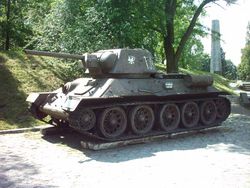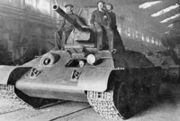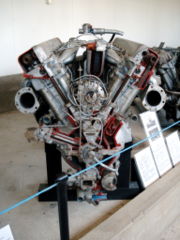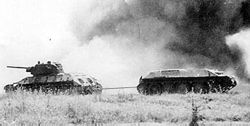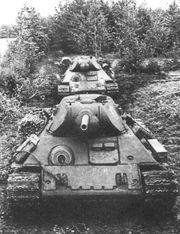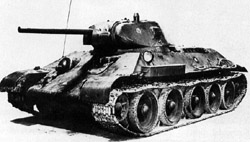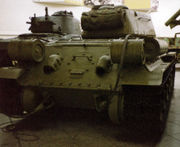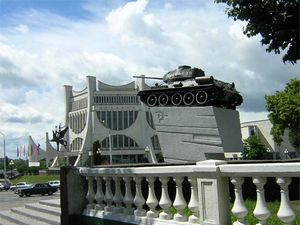T-34
2007 Schools Wikipedia Selection. Related subjects: Military History and War
The T-34 is a Soviet medium tank produced from 1940 to 1958. It was the world's best tank when the Soviet Union entered the Second World War, and although its armour and armament were surpassed by later WWII tanks, it is credited as the war's most effective, efficient and influential design. First produced at the KhPZ factory in Kharkov ( Kharkiv, Ukraine), it was the mainstay of Soviet armoured forces throughout World War II, and widely exported afterwards. It was the most-produced tank of the war, and the second most-produced tank of all time, after its successor, the T-54/55 series. The T-34 was still in service with twenty-seven countries as late as 1996.
Overview
The T-34 was developed from the BT series of Fast Tanks, and was intended to replace both the BT tank and the T-26 infantry tank in service. At its introduction, it was the tank with the best balance of firepower, mobility, and protection in existence, although initially its battlefield effectiveness suffered from the unsatisfactory ergonomic layout of its crew compartment, lack of radios and poor tactical employment.
In late 1943, the improved T-34-85 was introduced, with a more powerful gun. The design and construction of the tank were continuously refined during the war to improve effectiveness and decrease costs, allowing steadily greater numbers of tanks to be fielded. By the war's end in 1945, the versatile and cost-effective T-34 had replaced many light and heavy tanks in service, and accounted for the majority of Soviet tank production. It was influential in the development of the late twentieth-century concept of the main battle tank.
Production history
Revolutionary design
- "We had nothing comparable" — Friedrich von Mellenthin (1956)
Before 1939, the most numerous Soviet tanks were the T-26 light tank and the BT series of fast tanks. The T-26 was a slow-moving infantry tank, designed to keep pace with soldiers on the ground. The BT tanks were cavalry tanks, very fast-moving light tanks, designed to fight other tanks but not infantry. Both were thinly armoured, proof against small arms but not anti-tank rifles and 37mm anti-tank guns, and their gasoline-fueled engines liable to burst into flames "at the slightest provocation" (Zaloga & Grandsen 1984:111). Both were Soviet developments of foreign designs from the early 1930s: the T-26 based on the British Vickers 6-Ton, and the BT tanks based on a design from American engineer Walter Christie.
In 1937, engineer Mikhail Koshkin was assigned by the Red Army to lead a new team to design a replacement for the BT tanks, at the Kharkov Komintern Locomotive Plant (KhPZ) in Kharkov. The prototype tank, designated A-20, was specified with 20 mm of armour, a 45mm gun, and the new model V-2 engine, using less-flammable diesel fuel. It also had an 8×6-wheel convertible drive similar to the BT tank's 8×2, which allowed a tank to run on wheels without caterpillar track (Zheltov 1999). This feature had greatly saved on maintenance and repair of the unreliable tank track of the early 1930s and allowed tanks to travel over 85 km/h on roads, but gave no advantage in combat. By now, the designers considered it a needless waste of space and weight (Zaloga & Grandsen 1984:66, 111). The A-20 also incorporated previous research (BT-IS and BT-SW-2 projects) into sloped armour: its all-round sloped armour plates would be more likely to deflect armor-piercing shells than perpendicular armour.
Koshkin convinced Soviet leader Joseph Stalin to let him develop a second prototype, a more heavily armed and armoured "universal tank" which could replace both the T-26 and the BT tanks. The second prototype Koshkin named A-32, after its 32 mm of frontal armour. It also had a 76.2mm gun, and the same model V-2 diesel engine (Zaloga 1994:5). Both were tested in field trials at Kubinka in 1939, and the heavier A-32 proved to be as mobile as the A-20. Resistance from the military command and concerns about high production cost were finally overridden by anxieties about the poor performance of Soviet tanks in Finland and the effectiveness of Germany's Blitzkrieg in France. A still heavier version of the A-32 with 45 mm of front armour and wider tracks was approved for production as the T-34. Koshkin chose the name after the year 1934 when he began to formulate his ideas about the new tank, and to commemorate the decree expanding the armoured force and the appointment of Sergo Ordzhonikidze to head tank production (Zaloga 1994:6).
Two prototype T-34s were completed in January 1940, and underwent a gruelling 2,000-kilometre drive from Kharkov to Moscow for a demonstration for the Kremlin leaders, to the Mannerheim Line in Finland, and back to Kharkov via Minsk and Kiev, in April and May (Zaloga 1994:6). Some drive-train shortcomings were identified and corrected (Zaloga & Grandsen 1983:6). The first production tanks were completed in September 1940, completely replacing the production of the T-26, BT, and the multi-turreted T-28 medium tank at the KhPZ. Koshkin died of pneumonia at the end of that month, and the T-34's drive train developer, Alexander Morozov, was appointed Chief Designer.
The T-34 had the coil- spring Christie suspension of the BT, but dispensed with the weighty but ineffective convertible drive. It had well- sloped armour, a relatively powerful engine, and wide tracks. The initial version had a 76.2mm gun, and is often called T-34/76 (originally a World War II German designation). In 1944 a second major version began production, the T-34-85 (or T-34/85) with a larger turret mounting a larger 85mm gun.
Establishing and maintaining production
- "Quantity has a quality all its own" —attributed to Joseph Stalin
The T-34 posed new challenges for Soviet industry. It was the most heavily armoured medium tank produced to this point, and subassemblies originated at several plants: Kharkov Diesel Factory No. 75 supplied the model V-2 engine, Leningrad Kirovsky Factory (former Putilov works) made the original L-11 gun, and the Dinamo Factory in Moscow produced electrical components. Tanks were initially built at KhPZ No. 183, in early 1941 at the Stalingrad Tractor Factory (STZ), and starting in July shortly after the German invasion at Krasnoye Sormovo Factory No. 112 in Gorki. There were problems with defective armour plates, however (Zaloga 1983:6). Due to a shortage of new V-2 diesel engines, the initial production run from the Gorki factory were equipped with the BT tank's MT-17 gas-burning aircraft engine, and inferior transmission and clutch (Zheltov 2001:40–42). Only company commanders' tanks could be afforded to be fitted with radios. The L-11 gun did not live up to expectations, so the Grabin design bureau at Gorki Factory No. 92 designed a superior F-34 76.2mm gun. No bureaucrat would approve production, so Gorki and KhPZ started producing the gun anyway; official permission only came from Stalin's State Defence Committee after troops in the field sent back praise for the gun's performance (Zaloga & Grandsen 1984:130).
There was political pressure from conservative elements in the army to redirect resources into building the older T-26 and BT tanks, or to cancel T-34 production pending completion of the more advanced T-34M design. Germany's surprise attack against the Soviet Union in June 22, 1941 ( Operation Barbarossa) forced the Soviet Union to freeze further development, and shift into full production of tanks.
Germany's fast advances forced the monumental evacuation of tank factories to the Ural mountains. KhPZ was re-established around the Dzherzhinski Ural Railcar Factory in Nizhny Tagil, renamed Stalin Ural Tank Factory No. 183. The Kirovsky Factory was evacuated just weeks before Leningrad was surrounded, and moved with the Kharkov Diesel Factory to the Stalin Tractor Factory in Chelyabinsk, soon to be nicknamed Tankograd ('Tank City'). Voroshilov Tank Factory No. 174 from Leningrad was incorporated into the Ural Factory and the new Omsk Factory No. 174. The Ordzhonikidze Ural Heavy Machine Tool Works (UZTM) in Sverdlovsk absorbed several small factories. While these factories were relocating at record speed, the industrial complex surrounding the Stalingrad Tractor Factory produced forty percent of all T-34s (Zaloga & Grandsen 1983:13). As the factory became surrounded by heavy fighting in the Battle of Stalingrad, the situation there grew desperate: manufacturing innovations were necessitated by material shortages, and stories persist that unpainted T-34 tanks were driven out of the factory into the battlefields around it (Zaloga & Sarson 1994:23). Stalingrad kept up production until September 1942.
Barring this interruption, the only changes allowed on the production lines were to make the tanks simpler and cheaper to produce. New methods were developed for automated welding and hardening the plate, including innovations by Prof. Evgeny Paton. The design of the 76.2mm F-34 gun Model 1941 was reduced to 614 parts, compared to the earlier model's 861 (Zaloga & Grandsen 1984:131). Over two years, the production cost of the tank was reduced from 269,500 rubles in 1941, to 193,000, and then to 135,000 (Zaloga & Grandsen 1984:131). Production time was cut in half by the end of 1942, even though the majority of experienced factory workers were sent to the field and replaced by a workforce consisting of 50% women, 15% boys, and 15% invalids and old men. At the same time, new T-34s went from "beautifully crafted machines with excellent exterior finish comparable or superior to those in Western Europe or America" to much more roughly finished, although mechanical reliability was not compromised (Zaloga & Grandsen 1983:17).
Evolutionary development
- "The technological pace-setter of World War II tank design" — Steven Zaloga et al. (1997:3)
In 1942, a new hexagonal turret design derived from the abandoned T-34M project started to be built, improving the cramped conditions, and eventually adding a commander's cupola for all-round vision. Limited rubber supplies led to the adoption of steel-rimmed road wheels and a new clutch was added to the improved five-speed transmission and engine.
After German tanks with the superior long 75mm gun were fielded in 1942, Morozov's design bureau began a project to design an advanced T-43, aimed at increasing armour protection, while adding modern features like torsion-bar suspension and a three-man turret. The T-43 was intended to be a universal tank to replace both the T-34 and the KV-1 heavy tank, developed in direct competition with a Chelyabinsk heavy tank design bureau's KV-13 project. (Zaloga et al 1997:5)
But in 1943, the Soviets also encountered the new German Tiger and Panther tanks. Experience at the Battle of Kursk and reports from front-line commanders indicated that the T-34's 76.2mm gun was now inadequate. An existing 85mm antiaircraft gun was identified which was effective against the new German tanks, and could be adapted to tank use (Russian Battlefield 1998b). Unfortunately, the T-43 prototype's heavier armour was still not proof against the Tiger's 88mm gun, and its mobility was found to be inferior to the T-34's (and installing a heavier 85mm gun wouldn't have helped). Although it shared over 70% of its components with the T-34, committing to fabricating it would still have required a significant slow-down in production. (Zaloga et al 1997:5)
So the T-43 was cancelled, but the Soviet command made the difficult decision to retool the factories to produce a new model of T-34 with a turret ring enlarged from 1425mm to 1600mm, allowing a larger turret to be fitted. The T-43's turret design was hurriedly adapted to fit the T-34. The resulting new T-34-85 tank had a much superior gun and finally, a three-man turret with radio (which had previously been in the hull). Now the commander could just command the tank, leaving the operation of the gun to his gunner and loader.
Overall production slowed down somewhat while the new tank started its production run. Although a T-34-85 was still not a match for a Panther, its improved firepower levelled the playing field. The decision to improve on the existing design instead of implementing a new one allowed the Soviets to maintain such an overwhelming numerical advantage that the difference in capabilities could be considered moot. In May 1944, the Wehrmacht had only 304 Panthers operating on the Eastern Front, while the Soviets had ramped up T-34-85 production to a rate of 1,200 tanks per month (Zaloga et al 1997:6).
Cost-effectiveness
The cost to produce a T-34-85 tank was initially about thirty percent higher than a Model 1943, at 164,000 rubles, but by 1945 it was down to 142,000 (Harrison 2002:181). During the course of the war, the cost of a T-34 tank had been reduced by almost half, while in the meantime its mobility remained nearly the same, and its main gun's armour penetration and frontal armour thickness nearly doubled.
By the end of 1945, over 57,000 T-34s were built: 34,780 original T-34 tanks in 1940–44, and another 22,559 T-34-85s in 1944–45 (The Russian Battlefield 1998a, 1998b). After the war, the T-34 was out of large scale production in the USSR by 1946 when 2,701 were built. Production was restarted under licence in 1951 in the People's Republic of Poland and Czechoslovakia, where 1,380 and 3,185 T-34-85s were made, respectively, by 1956. (Later, T-54/55 and T-72 tanks would also be built outside the Soviet Union) In the late 1960s Soviet T-34-85s underwent a modernisation program (T-34-85M) for export and reserve service, being retrofitted with drive train components from the T-54/55 series tanks—a testament to the level of standardisation in Soviet tank design.
Estimates for total output of T-34 tanks are as high as 84,070, plus 13,170 self-propelled guns built on the T-34's chassis (Zaloga & Grandsen 1996:18). Some of these ended up in various Cold War conflicts around the world.
Variants
Identification of T-34 variants can be complicated. Turret castings and superficial details, and equipment differed between factories. New features were added in the middle of production runs or retrofitted to older tanks. Knocked-out tanks were rebuilt, sometimes with the addition of newer-model equipment and even new turrets. Some tanks also had appliqué armour made of scrap steel of varying thickness, welded on to the hull and possibly the turret; these tanks are called s ekranami ("with screens").
Model naming
German intelligence in World War II referred to the two main production models as T-34/76 and T-34/85, with minor models receiving letter designations such as T-34/76A—this nomenclature has been widely used in the West, especially in popular literature.
The Red Army never had a consistent policy for naming the production models (Zaloga 1994:19). Since at least the 1980s however, many academic sources (notably, AFV expert Steven Zaloga) have been using Soviet-style nomenclature: T-34 and T-34-85, with minor models distinguished by year, as T-34 Model 1940. This system is used here.
Some Russian histories use different names: they refer to the first T-34 as the T-34 Model 1939 instead of 1940, all T-34s with the original turret and F-34 gun as Model 1941 instead of Models 1941 and 1942, and hexagonal-turret T-34 as Model 1942 instead of 1943 (Zheltov 2001, passim).
Captured T-34s in German service were designated Panzerkampfwagen T-34(r), for Russland ('Russia').
The Finns called the T-34 Sotka after a diving duck common goldeneye, because the side silhouette of the tank resembles a swimming waterfowl (as related in the memoirs of Finnish tank ace Lauri Heino). The T-34-85 was called pitkäputkinen Sotka, 'long-barreled Sotka'.
Tank models
The T-34 (German designation: T-34/76) was the original tank with 76.2mm gun.
- Model 1940 (T-34/76A)—Early production run with interim L-11 76.2mm tank gun in a two-man turret.
- Model 1941 (T-34/76B)—Main production with heavier armour and the superior F-34 76.2mm gun.
- Model 1942 (T-34/76C)—Many minor manufacturing improvements.
- Model 1943 (T-34/76D, E, and F)—New cast hexagonal turret, nicknamed " Mickey Mouse" by the Germans because of its appearance with the twin, round turret-roof hatches open. Main production had a new commander's cupola.
- T-34/57— Fewer than 324 T-34s in 1941 and 1943–44 were fitted with the ZiS-4 or the ZIS-4M high-velocity 57mm gun to be used as tank hunters (Wachowski 2004). Some of them took part in the Battle of Moscow.
The T-34-85 (T-34/85) was a major improvement with a three-man turret and long 85mm gun.
- Model 1943—Short production run of February–March 1944 with D-5T 85mm gun.
- Model 1944—Main production, with simpler ZiS-S-53 85mm gun, radio moved from the hull into a turret with improved layout and new gunner's sight.
Various technical improvements continued to be made to the T-34-85, including major refurbishing programs in 1960 and 1969. All T-34-85 models are externally very similar.
Pre-war development of a more advanced T-34 tank was resumed in 1944, leading to the T-44. The new tank had a turret design based on the T-34-85's, but a new hull with torsion-bar suspension and transversely-mounted engine. It had a lower profile than the T-34-85 and was simpler to manufacture. Between 150 to 200 of these tanks were built before the end of the war. With some drive-train modifications and a new turret and gun, it became the T-54, starting production in 1947.
Czechoslovakian-built T-34-85s can be recognised by a semi-conical armoured fairing (like a rear-facing scoop) on the left rear slanting side panel of the engine compartment sponson. These were widely exported.
Other AFVs
- Flame-thrower tanks—OT-34 and OT-34-85 were fitted with an internally mounted flame-thrower replacing the hull machine gun.
- PT-34— Mine roller tank, mostly built on T-34 Model 1943 or T-34-85 chassis.
- Self-propelled guns—The T-34 chassis was used as the basis for a series of self-propelled guns
- SU-122
- SU-85
- SU-100
After the Second World War, some T-34s were fitted with 122mm howitzers as self-propelled artillery by Syria and Egypt.
Support vehicles
There were many support vehicles and even civilian tractors and cranes built on the T-34 chassis starting during the war and continuing at least into the 1990s. The vast majority of these were conversions of old or damaged tanks and self-propelled guns.
- Bridging tanks—Old tanks rebuilt in the field or at repair facilities. These were simply driven into water two abreast for special river-crossing operations, to be recovered later.
- Armoured recovery vehicles—During World War II, some old tanks were rebuilt as armoured recovery vehicles (ARVs), by plating over the turret ring or adding a superstructure. After the war, this repurposing program was formalized in successively more elaborate models.
Table of tank models
| T-34 Model 1940 |
T-34 Model 1941 |
T-34 Model 1942 |
T-34 Model 1943 |
T-43 prototype |
T-34-85 | T-44 | |
|---|---|---|---|---|---|---|---|
| Weight | 26 t | 26.5 t | 28.5 t | 30.9 t | 34 t | 32 t | 31.9 t |
| Gun | 76.2mm L-11 | 76.2mm F-34 | 76.2mm F-34 | 76.2mm F-34 | 76.2mm F-34 | 85mm ZiS-S-53 | 85mm ZiS-S-53 |
| Ammunition | 76 rounds | 77 rounds | 77 rounds | 100 rounds | 60 rounds | 58 rounds | |
| Fuel | 460 L | 460 L | 610 L | 790 L | 810 L | 642 L | |
| Road range | 300 km | 400 km | 400 km | 465 km | 300 km | 360 km | 300 km |
| Armour | 15–45 mm | 20–52 mm | 20–65 mm | 20–70 mm | 16–90 mm | 20–90 mm | 15–120 mm |
| Cost | 270,000 rubles | 193,000 rubles | 135,000 rubles | 164,000 rubles | |||
| Notes: dimensions, road speed, engine horsepower did not vary significantly, except for the T-43 which was slower than the T-34. References: Zaloga & Grandsen (1984:113, 184), Harrison (2002:181), KMDB (2006). | |||||||
Combat history
The T-34 is often used as a symbol for the effectiveness of the Soviet counterattack against the Germans. The appearance of the T-34 in the summer of 1941 was a psychological shock to German soldiers, who had been prepared to face an inferior Soviet enemy; this is shown by Alfred Jodl's diary, who seems to have been taken by surprise at the appearance of the T-34 in Riga. The T-34 could take on all 1941 German tanks effectively. However, the new tank suffered from severe mechanical problems, especially with its transmission and clutch—at least fifty percent of the first summer's total tank losses were due to breakdowns rather than German fire, although this also included old tanks in disrepair (Zaloga & Grandsen 1984:127). There was a shortage of recovery and repair equipment, and it was not uncommon for early T-34s to go into combat carrying a spare transmission on the engine deck. The mechanical troubles were eventually sorted out.
During the winter of 1941–42, the T-34 again dominated German tanks through its ability to move over deep mud or snow without bogging down. German tanks simply could not move over the same terrain the T-34 could handle. The German infantry, at that time armed mostly with PaK 36 37mm and PaK 38 50mm towed antitank guns, had no effective means of stopping T-34s. Only the poor level of Soviet crew training and the ineptitude of Soviet commanders prevented the T-34 from achieving greater success.
The emphasis in the Red Army in 1942–43 was on rebuilding the losses of 1941 and improving tactical proficiency. T-34 production increased rapidly, but the design was 'frozen'—generally, only improvements that sped production were adopted. Soviet designers were well aware of the need to correct certain deficiencies in the design, but these improvements would have cost production time and could not be adopted. By mid-1943 T-34 production was running at about one thousand tanks per month, much higher than the German rate. However, Soviet losses greatly exceeded German losses due to continued tactical inferiority.
In response to the T-34, the Germans were beginning to field larger numbers of high-velocity PaK 40 75mm guns, both towed and self-propelled. They were also able to put the Tiger heavy tank into the field in late 1942 and Panther medium tank by 1943. By mid-war the T-34 no longer held technical superiority over German tanks. Loss ratios remained unfavourable to the Soviets; as their technical superiority waned, their tactical proficiency was not catching up fast enough.
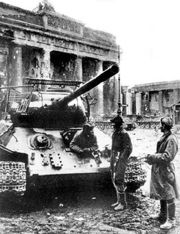
By the last years of the war, the Soviets' improving tactics remained inferior to the Germans', but the Red Army's growing operational and strategic skill and its larger inventory of tanks helped bring the loss ratios down (Zaloga & Grandsen 1984:223). The appearance of the T-34-85 in early 1944 gave the Red Army a tank that had better armour and mobility than German Pzkw IV and Sturmgeschütz III but it could not match the Panther in most respects. To the Soviet advantage there were far fewer Panthers than T-34s, and the T-34-85 was good enough to allow skilled crew and tactical situations to tip the balance.
At the outset of the war, T-34 tanks amounted to only about four percent of the Soviet tank arsenal, but by the war's end, they comprised at least 55% of the USSR's massive output of tanks (based on figures from Zaloga 1984:125–6, 225; Zheltov 2001 lists even larger numbers). By the time the T-34 had replaced older models and became available in greater numbers, newer German tanks (including the improved German design based on the T-34, the Panzer-V 'Panther') outperformed it. The Soviets' late-war Iosif Stalin heavy tanks were also better-armed and better-armoured than the T-34.
An obvious comparison can be made between the T-34 and the US M4 Sherman medium tank. Each tank formed the backbone of the armoured units in their own and allied armies. Both were good designs at the time they debuted. Both were improved significantly without much loss of effectiveness. Both could be manufactured in large numbers and maintained in difficult conditions. Neither could take on the best German Tiger and Panther tanks on equal terms, but too much has been made of this fact, as these heavy vehicles were both in a class more comparable to the Soviet IS-2 heavy tank (Zaloga & Grandsen 1983:37). Tanks were expected to have many roles on the battlefield, the foremost being infantry support and exploitation. The tank-vs-tank role is nonetheless very important. That German tank production was limited to relatively small numbers of superior but complex vehicles (in part because of production diversion into self-propelled guns) told against them. The Soviet decision to build large numbers of T-34s, gradually improving and simplifying the design, was a much better decision and helped to win the Second World War.
After World War II
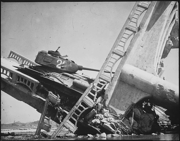
Since the Second World War, T-34-85s have been in use in many Soviet-client and formerly-Soviet client states. The North Korean invasion of South Korea in 1950 was spearheaded by a full brigade equipped with about 120 T-34-85s. There they were pitted against the M24 Chaffee, M4 Sherman and M26 Pershing but not the Centurion tanks of the UN forces. The 105th Armoured Brigade saw some early successes against South Korean infantry and U.S. M24 light tanks, but lost its momentum when faced with U.S. M26 medium tanks and infantry well-equipped with antitank weapons. After the first few months, North Korean armour was rarely encountered (Zaloga & Kinnear 1996:34–38).
T-34s equipped many of the Warsaw Pact Armies and were employed in the suppression of the Hungarian uprising in 1956. They were also used in the Middle East, the Vietnam War (most famously in the attack on Lang Vei) and even as recently as the Bosnian War. Croatia inherited twenty-five or thirty from Yugoslavia but has since withdrawn them from service. T-34s were sporadically available in Afghanistan (it is unknown if T-34s were used against coalition troops) and Saddam Hussein had T-34s in his army in the early 1990s. Several African states, including Angola and Somalia, have employed T-34-85s in recent years. Cuban T-34-85s have also seen action in Africa.
Cyprus National Guard forces equipped with some thirty-five T-34-85 tanks were used to enforce a coup by the Greek junta against democratically-elected President Archbishop Makarios on July 15, 1974. They also saw extensive action against Turkish forces during the Turkish Invasion in July and August 1974, with two major actions at Kioneli and at Kyrenia on July 20, 1974. (Drousiotis 2006)
China produced T-34 under the designation Type 58, though production soon stopped when Type 59 became available. A small number of T-34's have also been spotted in China, converted into fire-fighting vehicles.
The T-34 has been employed by the following 39 countries, as late as 1996 by 27 of them indicated by asterisks * (Zaloga & Kinnear 1996:34).
Europe and the Americas
Middle East and Asia
- Afghanistan*
- Egypt*
- Iraq
- Laos
- Lebanon*
- Libya*
- Mongolia*
- North Korea*
- People's Republic of China*
- Syria*
- Vietnam*
- South Yemen (PDRY)*
- North Yemen (YAR)
Africa
Combat effectiveness
- “The finest tank in the world” — Field Marshal Paul Ludwig Ewald von Kleist (Liddell Hart 1951)
Combat effectiveness of early war T-34s can best be evaluated in terms of 'hard' factors—armour, firepower, and mobility—and 'soft' factors: ergonomic features such as ease of use, vision devices, crew task layout and so forth. The T-34 was outstanding in hard factors and poor in soft ones.
The 'big three' of tank design have always been armour, firepower, and mobility. The T-34 was an outstanding balance of all three throughout its World War II life cycle. In 1941 its thick, sloped armour could defeat all German anti-armour weapons at normal ranges. T-34s could be knocked out only by the towed 88mm Flak guns or at close range by 50mm and 75mm short-barrelled tank guns. The majority of German tanks in 1941 did not have 75mm guns; indeed 37mm guns were far more common. By mid-1942 the T-34 was vulnerable to improved German weapons and remained so throughout the war, but its armour protection was equal to or superior to comparable tanks such as the US M4 Sherman or German Pzkw-IV. In terms of firepower, the T-34's 76mm gun could penetrate any 1941 German tank with ease. This gun also fired an adequate HE round. In 1943, the 76mm was out-ranged by the Panther's long 75mm and the Tiger's 88mm. The introduction of the Soviet 85mm gun in 1944 did not make the T-34-85 equal in firepower, but the 85mm could penetrate both Panthers and Tigers at reasonable ranges.
In terms of mobility, the T-34's wide track, good suspension and large engine gave it unparalleled cross-country performance. First-generation German tanks could not begin to keep up.
Overall then, in hard factors the T-34 was the worldwide trend-setter for tank development in the first half of the war.
In terms of ergonomics, the T-34 was poor, despite some improvements during the war. All 76mm-armed versions were greatly hampered by the cramped two-man turret layout. The commander's battlefield visibility was poor; the forward-opening hatch forced him to observe the battlefield through a single vision slit and traversable periscope. He was also over-tasked by having to fire the main gun. In contrast, contemporary German, British and US medium tanks had much superior three-man turrets with commander, gunner and loader. The three-man turret layout allowed the tank commander to concentrate on leading his crew and co-ordinating his actions with the rest of his unit, without having to manage an individual task such as laying or loading the gun. This makes an enormous contribution to crew effectiveness. The T-34-85 corrected this problem, which had been recognised before the war. Many German commanders liked to fight "heads-up", with the seat raised and having a full field of view. In the 76mm-armed versions of the T-34, this was impossible (Zaloga & Grandsen 1984:135–7).
Visibility from the driver's seat was also poor. Tactically, this affected the driver's ability to use terrain to their advantage, since he could not see folds in the ground as well, or have as wide a range of vision as in some other tanks.
The loader also had a difficult job due to the lack of a turret basket (a rotating floor that moves as the turret turns). This problem was shared with many other tanks, for example, the US M-3 Stuart. The floor under the T-34's turret was made up of ammunition stored in small metal boxes, covered by a rubber mat. There were nine ready rounds of ammunition stowed in racks on the sides of the fighting compartment. Once these initial nine rounds were fired in combat, the crew had to pull additional ammunition out of the floor boxes, leaving the floor littered with open bins and matting. This distracted the crew and degraded their performance (Zaloga & Grandsen 1984:137).
Other key factors diminishing the initial impact of T-34s on the battlefield were the poor state of leadership, tank tactics, and crew training, a hangover from Stalin's purges of the Soviet officer corps in the late 1930s, which were aggravated by the loss of the best-trained personnel during the disastrous defeats suffered by the Red Army in 1941. Many crews went into combat with only their basic military training plus seventy-two hours of classroom instruction. These problems were exacerbated by the T-34's poor ergonomics and lack of radios during the early war, making it practically impossible to co-ordinate tank units in combat. German tank soldiers found that the Soviet armour attacked in rigid formations and took little advantage of terrain (Zaloga & Grandsen 1984:126–27, 135). By 1943–44 these problems had largely been corrected, although Soviet crew training never reached the level of German training.
The durability of the T-34 is is underlined by the recovery in 2000 of a T-34 Model 1943 which had spent 56 years at the bottom of a bog in Estonia. The tank had been captured and used by retreating German troops, who dumped it in the swamp when it ran out of fuel. There were no signs of oil leakage, rust, or other significant water damage to the mechanical components. The engine was restored to full working order.
Tank as a symbol
Hundreds of T-34s were installed as war memorials in Soviet-bloc countries.
At least one such tank, mounted atop the monument to Soviet tank crews in Prague, was the focus of significant controversy. The monument, intended to represent Lt I.G. Goncharenko's T-34-85, the first Soviet tank to enter Prague in May 1945, actually bore an IS-2m heavy tank. To many in Prague, the tank was also a reminder of the Soviet invasion which ended the Prague Spring of 1968. The tank was painted pink by artist David Černý in 1991. Following an official protest from the Russian government, the arrest of Černý, a coat of official green paint, public demonstrations, and a further coat of pink paint applied by fifteen parliamentary deputies, the tank was finally removed to a military museum (Wright 2001:379, Zaloga & Kinnear 1996:42–43). Another T-34 formerly painted pink is the Mandela Way Tank in London.
Four tankers and a dog ( Czterej pancerni i pies) was a very successful Polish television series of the 1960s which made T-34 tank number 102 an icon of Polish popular culture. It was also shown in other Soviet-bloc countries, and was especially well received the German Democratic Republic. It is now re-run in Czech Republic television, with apparent success.
The news on the unconventional use of T-34 broke, quite unexpectedly, from Budapest on October 23, 2006. A month-long crisis centred around the Ferenc Gyurcsány cabinet scandal climaxed during the official fiftieth anniversary of the 1956 Hungarian Revolution. Protesters managed to run an unarmed T-34 tank which was part of a memorial exhibition and used it in riots against police forces.
Importance
- "The impression that it made was to influence greatly subsequent tank development throughout the world" — John Milsom (1975)
The T-34 was among the most important weapons systems in the Red Army in the Second World War. Since the Soviet-German front was the decisive land theatre of the Second World War, the importance of the T-34 can hardly be exaggerated. At the time it was first fielded in 1940, it was easily the finest tank design in the world. By mid-war it was no longer technically superior to all its opponents, but it was still better than most, and it was available in huge numbers.
The improved T-34-85 remained the standard Soviet medium tank with an uninterrupted production run until the end of the war. The Germans responded to the T-34 by introducing completely new, very expensive and complex second-generation tanks, greatly slowing the growth of their tank production and allowing the Soviets to maintain a substantial numerical superiority in tanks (Zaloga & Grandsen 1983:37). The T-34 replaced most light, medium, and heavy tanks in Soviet service. Its evolutionary development would lead directly to the T-44 and T-54/55 series of tanks, built until 1981 and still operated today.
The effectiveness of the T-34 tank, when employed with the lessons of mobile combined-arms operations learned in the war, would have a profound impact on the practice of warfare. The infantry tank/ cavalry tank concept was shown to be obsolete, and abandoned by all nations by the war's end. While more economical types of vehicles would take over the various supporting roles of tanks, well-balanced medium tank designs could become more specialized and optimized for their role in mechanized warfare. The demonstrated potential of the medium tank would lead to the development of the modern main battle tank (MBT).
Surviving vehicles
There are hundreds of surviving T-34s. Examples of this tank are in the collections of most significant military museum, and hundreds more serve as war memorials. Many are in private ownership, and demilitarised working tanks change hands for between $20,000 and $40,000 USD.
Significant surviving T-34s include a Model 1941 at the US Army Ordnance Museum in Aberdeen, Maryland. This is one of the oldest surviving vehicles. Other older 76 mm-armed T-34s have recently been recovered from old battle sites, but there is no known remaining T-34 Model 1940, with an L-11 gun.
